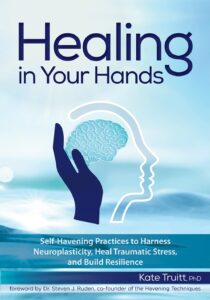The Havening Technique is a groundbreaking self-soothing method designed to help individuals reduce stress, anxiety, and trauma by altering how distressing memories are stored in the brain. Rooted in neuroscience, this technique focuses on the brain’s ability to heal itself by changing the way it processes emotional distress. By using a combination of gentle touch, eye movements, and positive affirmations, Havening creates a sense of safety, calm, and emotional resilience.
Origins of Havening
The Havening Technique was developed by Dr. Ronald Ruden, a medical doctor, neuroscientist, and author based in New York City. In the early 2000s, Dr. Ruden began extensive research into the neurobiology of trauma and emotional distress, seeking a method that could help individuals heal from deeply rooted emotional pain. By 2004, his research culminated in the development of the Havening Technique, which he introduced as a “psycho-sensory” approach—using sensory input to affect psychological well-being.
Dr. Ruden’s work combined his background in neuroscience with his passion for understanding the human mind’s ability to heal. His groundbreaking book, When the Past Is Always Present (2011), detailed the science behind traumatic encoding in the brain and laid the foundation for the Havening Technique.
How Havening Works
Havening is based on the principles of neuroscience, particularly how the brain encodes and stores traumatic memories. When an individual experiences emotional distress or trauma, these memories are stored in the amygdala—the brain’s fear center—through electrochemical processes. These stored memories can trigger anxiety, fear, and emotional pain when recalled.
The goal of Havening is to “depotentiate” these traumatic memories, reducing their emotional charge. By using sensory input, such as touch and visualization, the brain generates delta waves—slow, soothing brain waves associated with relaxation and healing. This process helps rewire how the brain perceives and reacts to distressing memories, replacing fear and anxiety with calm and safety.
The Three Main Components of Havening
- Havening Touch
The foundation of the technique is gentle, rhythmic touch. This includes softly stroking the arms, hands, or face. The touch signals safety to the brain, stimulating the production of calming brain waves and reducing stress hormones. - Distraction Techniques
To help the brain disengage from distressing thoughts, Havening uses distraction methods such as positive visualizations, counting, humming, or repeating affirmations. This keeps the mind occupied, allowing the brain to process and neutralize emotional distress. - Eye Movements
Similar to Eye Movement Desensitization and Reprocessing (EMDR), Havening incorporates specific eye movements that help the brain process traumatic memories. Moving the eyes in particular patterns aids in breaking the connection between the memory and its emotional charge.
Benefits of the Havening Technique
- Reduces Stress and Anxiety: Havening helps calm the nervous system, lowering cortisol levels and promoting relaxation.
- Processes Trauma and PTSD: By altering how traumatic memories are stored, Havening can reduce emotional pain and help people move past traumatic events.
- Promotes Emotional Resilience: The technique builds the brain’s capacity to handle future stress more effectively.
- Encourages Self-Soothing and Relaxation: As a self-help tool, Havening empowers individuals to manage their emotions and find calm in challenging moments.
- Supports Rewiring Negative Thought Patterns: By interrupting negative thought loops, Havening helps create new, more positive neural pathways.
How to Use Havening
Havening can be practiced in two ways:
- Self-Havening: This is an easy-to-learn, at-home practice. Individuals can use Havening Touch combined with visualizations and affirmations whenever they feel stressed or overwhelmed.
- Guided Havening with a Practitioner: For deeper healing work, a certified Havening practitioner can guide individuals through the process, especially when working through complex trauma or PTSD.
The Science Behind the Calm
What makes Havening so powerful is its foundation in neuroscience. Research has shown that when delta waves are stimulated through Havening Touch, the brain becomes more receptive to change. This creates an optimal state for emotional healing, allowing traumatic memories to lose their emotional charge and become “just another memory” without the pain attached.
The Havening Technique offers a simple yet powerful approach to emotional healing. Whether you’re dealing with everyday stress or processing deeper trauma, Havening empowers you to take control of your emotional well-being. Its blend of neuroscience and self-care creates a path to greater calm, resilience, and inner peace.
With just a few minutes of practice, Havening can help rewire your brain for relaxation and healing—offering a sanctuary of calm in a chaotic world.



